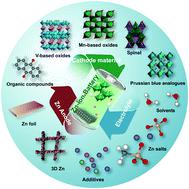当前位置:
X-MOL 学术
›
Chem. Soc. Rev.
›
论文详情
Our official English website, www.x-mol.net, welcomes your
feedback! (Note: you will need to create a separate account there.)
Materials chemistry for rechargeable zinc-ion batteries.
Chemical Society Reviews ( IF 40.4 ) Pub Date : 2020-06-01 , DOI: 10.1039/c9cs00349e Ning Zhang 1 , Xuyong Chen 2 , Meng Yu 2 , Zhiqiang Niu 2 , Fangyi Cheng 2 , Jun Chen 2
Chemical Society Reviews ( IF 40.4 ) Pub Date : 2020-06-01 , DOI: 10.1039/c9cs00349e Ning Zhang 1 , Xuyong Chen 2 , Meng Yu 2 , Zhiqiang Niu 2 , Fangyi Cheng 2 , Jun Chen 2
Affiliation

|
Rechargeable zinc-ion batteries (ZIBs) are promising for large scale energy storage and portable electronic applications due to their low cost, material abundance, high safety, acceptable energy density and environmental friendliness. This tutorial review presents an introduction to the fundamentals, challenges, recent advances and prospects related to ZIBs. Firstly, the intrinsic chemical properties, challenges and strategies of metallic zinc anodes are underscored. Then, the multiple types of cathode materials are classified and comparatively discussed in terms of their structural and electrochemical properties, issues and remedies. Specific attention is paid to the mechanistic understanding and structural transformation of cathode materials based on Zn ion-(de)intercalation chemistry. After that, the widely investigated electrolytes are elaborated by discussing their effect on Zn plating/stripping behaviours, reaction kinetics, electrode/electrolyte interface chemistries, and cell performances. Finally, the remaining challenges and future perspectives are outlined for the development of ZIBs.
中文翻译:

可充电锌离子电池的材料化学。
可充电锌离子电池(ZIB)低成本,材料丰富,安全性高,可接受的能量密度和环境友好性,因此有望用于大规模储能和便携式电子应用。本教程的回顾介绍了与ZIB相关的基础知识,挑战,最新进展和前景。首先,强调了金属锌阳极的内在化学性质,挑战和策略。然后,对多种类型的正极材料进行分类,并就其结构和电化学性能,问题和补救措施进行了比较讨论。特别注意基于Zn离子-(脱)插层化学的正极材料的机械理解和结构转变。之后,通过讨论电解质对锌电镀/剥离行为,反应动力学,电极/电解质界面化学以及电池性能的影响,详细阐述了电解质。最后,概述了开发ZIB的剩余挑战和未来前景。
更新日期:2020-07-06
中文翻译:

可充电锌离子电池的材料化学。
可充电锌离子电池(ZIB)低成本,材料丰富,安全性高,可接受的能量密度和环境友好性,因此有望用于大规模储能和便携式电子应用。本教程的回顾介绍了与ZIB相关的基础知识,挑战,最新进展和前景。首先,强调了金属锌阳极的内在化学性质,挑战和策略。然后,对多种类型的正极材料进行分类,并就其结构和电化学性能,问题和补救措施进行了比较讨论。特别注意基于Zn离子-(脱)插层化学的正极材料的机械理解和结构转变。之后,通过讨论电解质对锌电镀/剥离行为,反应动力学,电极/电解质界面化学以及电池性能的影响,详细阐述了电解质。最后,概述了开发ZIB的剩余挑战和未来前景。











































 京公网安备 11010802027423号
京公网安备 11010802027423号